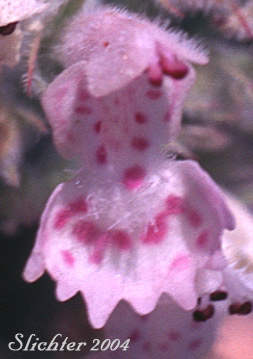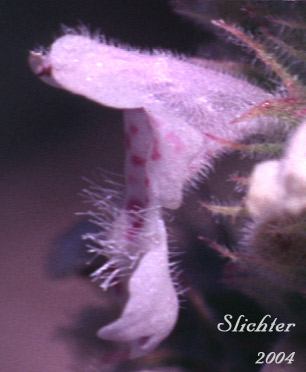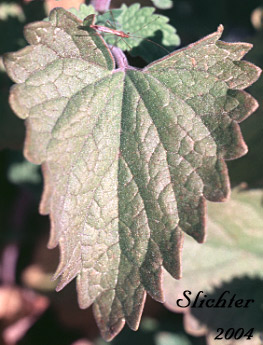



 The
photo at right shows the triangular leaf of catnip. Note the coarsely toothed
margin and the cordate base to the leaf blade. Photographed near Page Springs
at the western base of the Steens Mt., southeastern Oregon........July 30,
2004.
The
photo at right shows the triangular leaf of catnip. Note the coarsely toothed
margin and the cordate base to the leaf blade. Photographed near Page Springs
at the western base of the Steens Mt., southeastern Oregon........July 30,
2004.
Catnip is freely branched, several-stemmed perennial with several stems arising from 30-100 cm high from a taproot. The branches that are present turn upward and follow fairly closely to the main stem. The stem and leaves are covered with numerous fine, spreading and fairly short hairs that are white or gray in color. All the leaves are found on the stems, and these are only slightly reduced upwards on the stem. The leaf blades are triangular-ovate in outline with slightly heart-shaped bases, or the leaf bases may be abruptly squared off to the petiole. They measure from 2-7 cm long and 1.5-5 cm long. The petioles are up to half the length of the blade while the margins are ringed with coarse, rounded teeth. The inflorescence is a short, dense and consists of several verticillasters arising from the upper axils. This terminal spike is roughly 2-8 cm long and from 1.5-2.5 cm wide. The calyx, which measures from 5-7 mm long, is tubular with 5 fairly regular teeth which are long, thin and with pointed tips. The calyx teeth are shorter than the tube. The whitish corolla is commonly spotted with red or purple marks and is less than twice as long as the calyx. The upper lip of the corolla is hooded but cleft at its middle, while the large lower lip is sharply reflexed downwards at up to a ninety degree angle from the tube. The wide central lobe of the lower lip has fairly large, irregularly rounded teeth around its margin.
Catnip, a weedy species, may be found in disturbed areas near roads, waste areas, open woods, and along streambanks. It may also be found in fairly undisturbed moist habitats.
Catnip, a native of Eurasia, is now naturalized across much of North America. In the Pacific Northwest, it is more common west of the Cascades, but may also be found in disturbed areas east of the mountains.
In the Columbia River Gorge, it may be found between the elevations of 100'-800' at various locations between the Sandy River in the west and the mouth of the Deschutes River in the east. I have personally seen it at the sand dunes at the east side of the airport across from The Dalles and along the trail along the east bank of the the Deschutes River just upstream from its mouth.